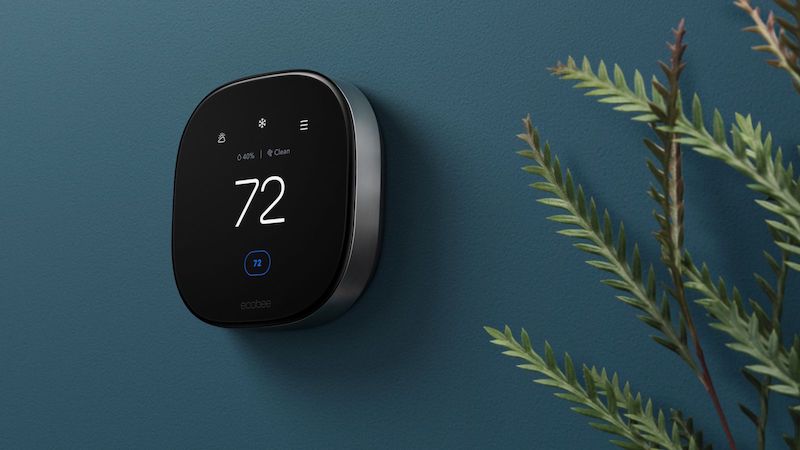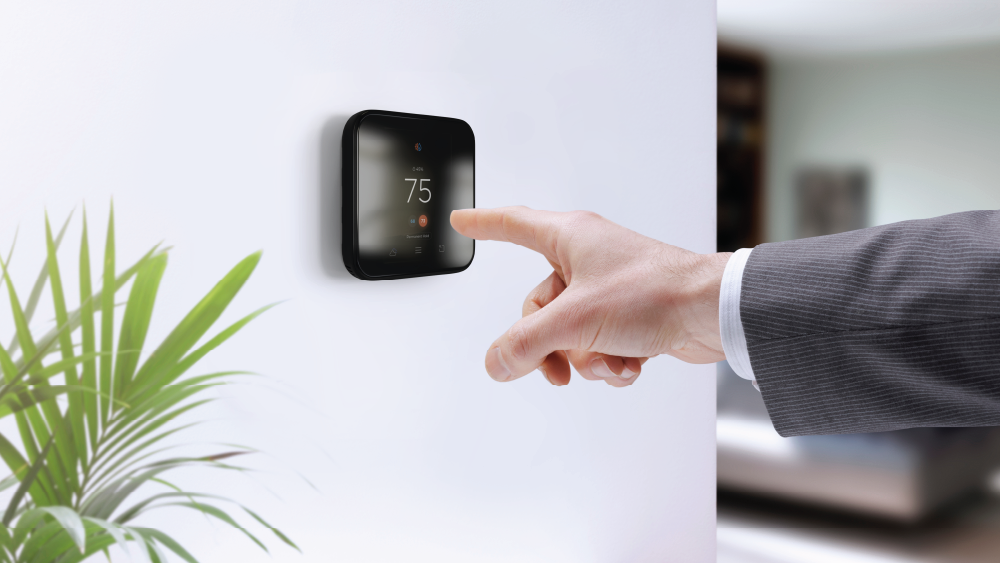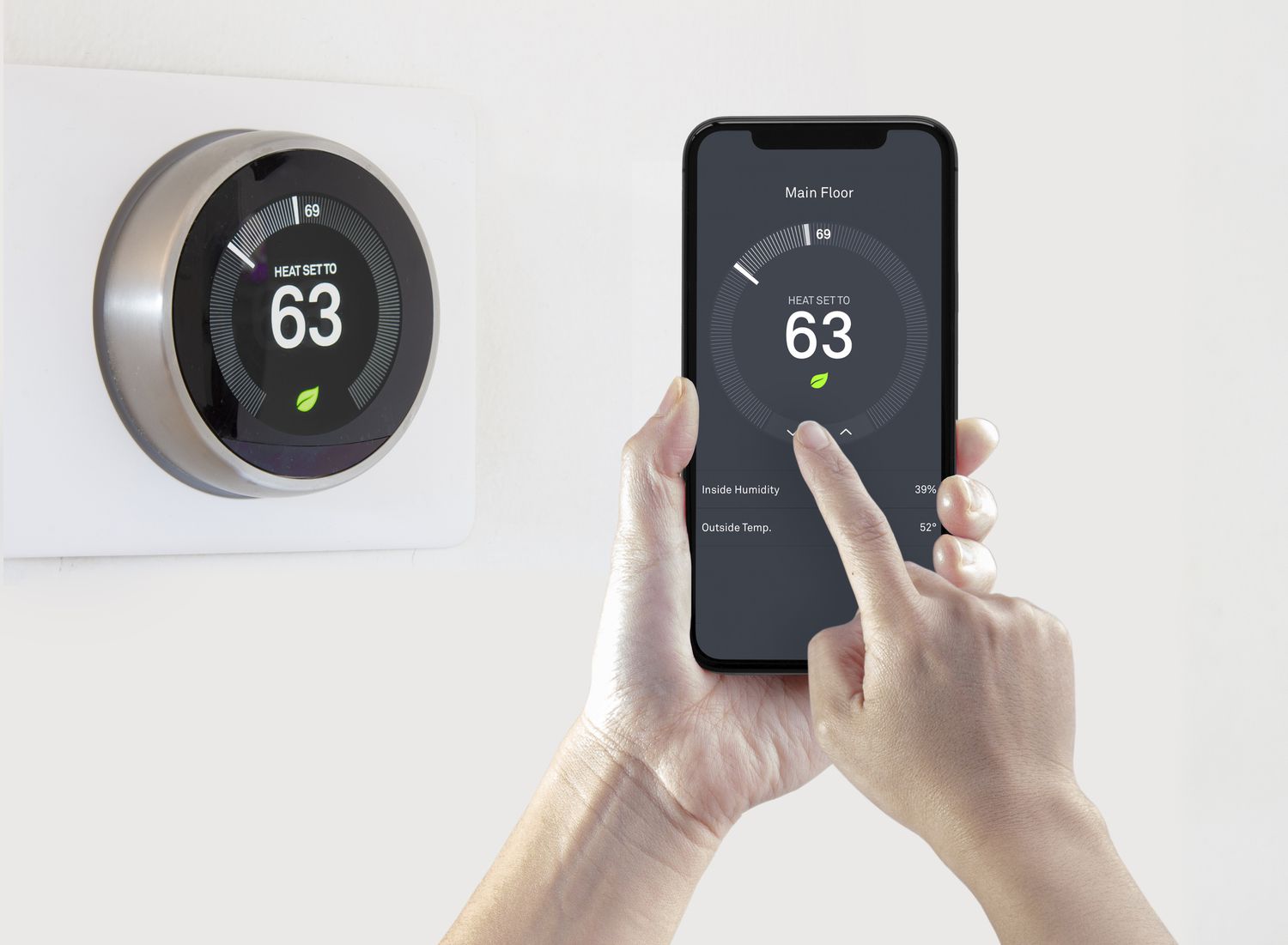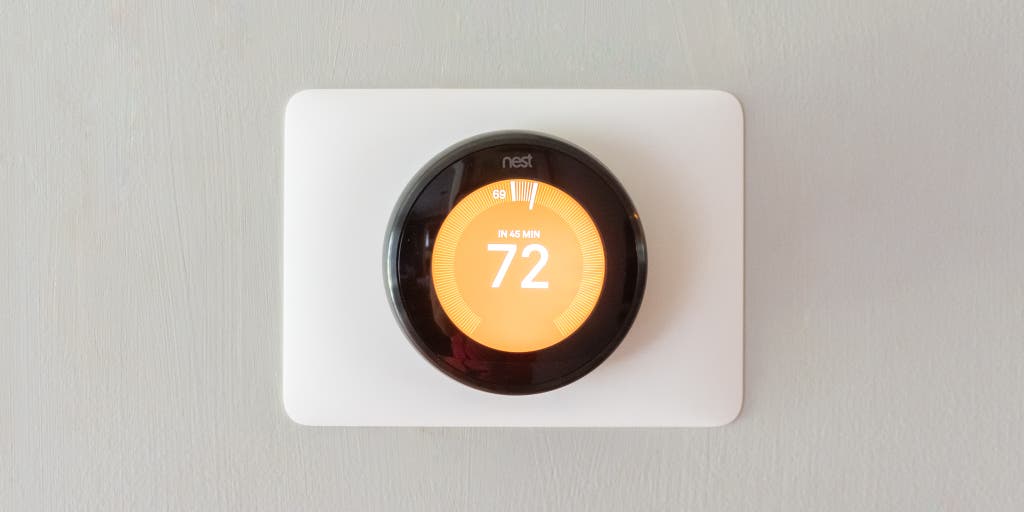Send us an email
Please enter your name and contact info.
Please enter your name and contact info.
Call Us Today! (850) 748-1066

Serving Families Throughout Pensacola
In the modern world, where energy efficiency is a top priority, smart thermostats have emerged as a game-changer. With their ability to intelligently regulate temperature settings and adapt to your lifestyle, smart thermostats not only provide a comfortable living environment but also maximize energy efficiency. By seamlessly learning your heating and cooling habits, these innovative devices can optimize energy consumption, resulting in significant cost savings and reduced environmental impact. In this article, we will explore the numerous benefits of smart thermostats and how they can revolutionize the way we control and manage our home’s temperature.

This image is property of roboticsandautomationnews.com.
Smart thermostats are innovative devices that have revolutionized the way we control the temperature in our homes. These thermostats are equipped with advanced technology, allowing you to have greater control over your heating and cooling systems. Unlike traditional thermostats, smart thermostats can be controlled remotely through your smartphone or other smart devices. They offer a wide range of features that not only enhance comfort but also help you save energy and reduce your utility bills. With their sleek and modern designs, smart thermostats are not only functional but also aesthetically pleasing additions to any home.
Smart thermostats are devices that use advanced technology to control the temperature of your home. They are designed to replace traditional thermostats, offering a more convenient and efficient solution for heating and cooling. These thermostats often come with Wi-Fi connectivity, allowing you to control them remotely through a mobile app or a smart assistant.
Some of the key features of smart thermostats include:
Wi-Fi connectivity: This allows you to control your thermostat remotely using your smartphone or other smart devices. You can adjust the temperature, set schedules, and receive energy usage reports from anywhere.
Learning capabilities: Smart thermostats can learn your heating and cooling preferences and automatically adjust the temperature based on your needs. They can also adapt to your schedule and make energy-saving adjustments when you’re away.
Geofencing: This feature uses your smartphone’s location to automatically adjust the temperature when you leave or return home. It ensures that your home is always at a comfortable temperature while saving energy when no one is home.
Energy monitoring: Smart thermostats provide real-time energy usage reports, allowing you to track and analyze your energy consumption. This feature helps you identify areas for improvement and make more informed decisions to reduce your energy usage.
There are several types of smart thermostats available in the market, each offering its own set of features and capabilities. Here are some of the most popular types:
Wi-Fi Enabled Thermostats: These thermostats connect to your home’s Wi-Fi network, allowing you to control them remotely through a mobile app or a smart assistant. They offer advanced features such as learning capabilities and energy monitoring.
Programmable Thermostats: These thermostats allow you to create custom heating and cooling schedules to fit your needs. They can be programmed to adjust the temperature based on your daily routine, saving energy when you’re not at home.
Smart Thermostats with Room Sensors: These thermostats come with additional room sensors that measure the temperature and occupancy of different areas in your home. They adjust the temperature accordingly, ensuring optimal comfort and energy efficiency in each room.
Voice-Activated Thermostats: These thermostats can be controlled using voice commands through a smart assistant such as Amazon Alexa or Google Assistant. They offer a hands-free and convenient way to adjust the temperature in your home.
There are several reputable brands that manufacture smart thermostats. Some of the most popular brands include:
Nest: Nest thermostats are known for their sleek design and advanced learning capabilities. They can adapt to your schedule and automatically adjust the temperature to save energy. Nest thermostats also offer integration with other smart home devices.
Ecobee: Ecobee thermostats are known for their room sensor technology, which allows for precise temperature control in different areas of your home. They also offer smart assistant integration and energy monitoring features.
Honeywell: Honeywell offers a range of smart thermostats with different features and price points. They are known for their reliability and compatibility with a wide range of HVAC systems.
Emerson: Emerson thermostats offer a combination of advanced features and affordability. They provide energy-saving features such as geofencing and scheduling options.

This image is property of cielowigle.com.
Smart thermostats offer numerous benefits that can enhance your comfort, convenience, and energy efficiency. Here are some of the key advantages of using smart thermostats in your home:
One of the primary benefits of using a smart thermostat is its ability to save energy. These thermostats use advanced algorithms to analyze your energy usage patterns and make adjustments accordingly. They can learn your preferences and automatically adjust the temperature when you’re away or asleep. By optimizing your heating and cooling systems, smart thermostats can significantly reduce your energy consumption and lower your utility bills.
With smart thermostats, you can control your home’s temperature from anywhere using your smartphone or other smart devices. Whether you’re at work, on vacation, or lying in bed, you can easily adjust the temperature to your liking. This level of convenience ensures that your home is always at a comfortable temperature when you arrive and helps you avoid wasting energy by heating or cooling an empty house.
Smart thermostats offer a high level of customization to suit your individual preferences. You can easily create heating and cooling schedules that align with your daily routine and lifestyle. Additionally, these thermostats have learning capabilities that adapt to your behavior over time. They learn your preferred temperature settings and adjust automatically, providing personalized comfort without the need for constant manual adjustments.
When it comes to choosing a smart thermostat for your home, there are several factors to consider. Here are some key considerations that can help you make the right decision:
Before purchasing a smart thermostat, it’s important to ensure compatibility with your HVAC (heating, ventilation, and air conditioning) system. Check the specifications and requirements of the thermostat to ensure it is compatible with your existing equipment. In some cases, professional installation or additional wiring may be necessary to make the thermostat compatible.
If you have other smart home devices or a smart assistant in your home, consider choosing a smart thermostat that offers integration with your existing ecosystem. This allows for seamless control and automation of your entire smart home system.
Consider your budget when choosing a smart thermostat. Prices can vary depending on the brand, features, and capabilities of the thermostat. Additionally, think about whether you prefer a DIY installation or if you would rather hire a professional to install the thermostat for you.

This image is property of hub.berlin.
Installing a smart thermostat can be a straightforward process if you follow the necessary steps. Here is a step-by-step guide to help you through the installation and setup process:
Before you begin the installation process, determine the compatibility of the smart thermostat with your HVAC system. Refer to the user manual or the manufacturer’s website to confirm if the thermostat is compatible. Make note of any additional equipment or wiring that may be required.
Gather the necessary tools and equipment for the installation. This may include a screwdriver, wire cutters/strippers, electrical tape, and a power drill (if wall mounting is required). Ensure that you have the correct tools and that they are in good working condition.
Turn off the power: Before starting any electrical work, turn off the power to your HVAC system at the circuit breaker.
Remove the old thermostat: Carefully remove the cover of your old thermostat, revealing the wiring. Take note of the wire connections and label them according to the terminals they are connected to. Unscrew the thermostat from the wall.
Install the new thermostat base: If necessary, install the new thermostat base onto the wall using the provided screws and a power drill. Ensure that the base is level and securely fastened.
Connect the wires: Take the labeled wires and connect them to their corresponding terminals on the new thermostat base. Use wire connectors or the terminal blocks provided with your thermostat to secure the connections.
Attach the thermostat cover: Once the wiring is complete, attach the cover to the new thermostat base. Ensure that it is aligned properly and snaps into place.
Restore power: Turn the power back on at the circuit breaker and verify that the thermostat display is powered on.
Follow the setup instructions: Consult the user manual or the manufacturer’s website for the specific setup instructions for your smart thermostat. This may include connecting the thermostat to your Wi-Fi network and downloading the corresponding mobile app.
Configure your thermostat: Follow the on-screen prompts or the instructions provided by the manufacturer to configure your thermostat settings. Set your desired temperature preferences, create schedules, and enable any additional features or settings.
Programming and scheduling your smart thermostat is crucial for maximizing energy efficiency and maintaining a comfortable home environment. Here are some tips for effectively programming and scheduling your thermostat:
When programming your thermostat, set temperature levels that ensure comfort based on your daily routine and preferences. Consider the time you usually wake up, leave for work, return home, and go to sleep. By setting appropriate temperatures for each time period, you can enjoy optimal comfort without wasting energy.
Take advantage of your smart thermostat’s scheduling capabilities to create energy-efficient schedules. Identify times when you are typically away from home or asleep, and program the thermostat to reduce heating or cooling during those periods. By adjusting the temperature when you don’t need it, you can save energy and lower your utility bills.
Smart thermostats often offer different modes for specific scenarios. For example, some thermostats have an “Away” mode that allows you to set your desired temperature for when you’re away from home. This prevents unnecessary heating or cooling while you’re out. Similarly, thermostats may have an “Eco” mode that prioritizes energy savings by adjusting the temperature slightly to save energy without sacrificing comfort.

This image is property of uploads-ssl.webflow.com.
Smart thermostats come with a range of advanced features that can further enhance their efficiency and convenience. Here are some key features to utilize:
Take advantage of the geofencing feature of your smart thermostat. Geofencing uses your smartphone’s location to automatically adjust the temperature when you leave or return home. By setting a radius around your home, the thermostat can detect when you’re approaching or leaving and adjust the temperature accordingly. This prevents unnecessary heating or cooling when no one is home, saving energy and reducing your utility bills.
If your smart thermostat has occupancy sensors, make sure they are properly positioned to detect occupancy in each room. This ensures that the thermostat adjusts the temperature based on the occupancy of individual rooms, providing personalized comfort and energy efficiency.
Regularly monitor your smart thermostat’s energy usage reports to track and analyze your energy consumption. Use this data to identify trends and make informed decisions about adjusting temperature settings or creating more energy-efficient schedules. Energy monitoring can help you identify energy-saving opportunities and optimize your heating and cooling systems.
If you have a smart assistant such as Amazon Alexa or Google Assistant, integrate it with your smart thermostat. This allows for voice control and hands-free adjustment of the temperature. You can simply issue commands to your smart assistant to raise or lower the temperature, create custom schedules, or enable specific thermostat settings.
To maximize energy efficiency with your smart thermostat, consider implementing the following tips:
Set your thermostat at an optimal temperature range that provides comfort without wasting energy. In general, a temperature setting of around 68-72°F (20-22°C) during cooler months and 75-78°F (24-26°C) during warmer months is recommended. Adjusting the temperature slightly can have a significant impact on energy savings.
When you’re away from home or asleep, utilize the “Away” or “Eco” mode on your smart thermostat to reduce heating or cooling. This ensures that energy is not wasted on empty rooms. Ensure that you program these modes to activate during your typical periods of absence and adjust the temperature to a level that minimizes energy consumption.
If your smart thermostat supports zoning or has room sensors, make use of these features to control the temperature in different areas of your home. By adjusting the temperature based on occupancy or the specific needs of each room, you can optimize comfort and energy efficiency.

This image is property of cdn.thewirecutter.com.
While smart thermostats are generally reliable, you may encounter some common issues. Here are some troubleshooting tips for common problems:
If you’re experiencing connectivity issues with your smart thermostat, try the following steps:
Check the Wi-Fi connection: Ensure that your smart thermostat is connected to a stable Wi-Fi network. If the signal is weak, consider moving the router closer to the thermostat or installing a Wi-Fi range extender.
Restart the thermostat: Power-cycle your smart thermostat by turning it off and on again. This can help resolve minor connectivity issues.
Check the app or firmware: Update the mobile app or firmware associated with your smart thermostat. Manufacturers often release updates to improve functionality and address connectivity issues.
If you notice that your smart thermostat’s temperature readings are inaccurate, or the thermostat is not responding to the room temperature correctly, consider the following steps:
Check for sensor obstructions: Ensure that the temperature sensors on your smart thermostat are not covered or blocked by any objects. Remove any obstructions that might interfere with accurate temperature readings.
Recalibrate the thermostat: Some smart thermostats allow you to recalibrate the temperature readings to ensure accuracy. Refer to the user manual or the manufacturer’s website for instructions on how to recalibrate your specific model.
Seek professional assistance: If you have tried troubleshooting steps and are still experiencing sensor or calibration issues, it may be necessary to contact a professional HVAC technician for further assistance.
To ensure optimal performance and access to the latest features, regularly check for software and firmware updates for your smart thermostat. These updates often include bug fixes, security enhancements, and new features. Refer to the user manual or the manufacturer’s website for instructions on updating your thermostat’s software or firmware.
Maintaining your smart thermostat is important to ensure its proper functioning and longevity. Here are some maintenance tips:
Clean your smart thermostat periodically to remove dust and dirt buildup. Use a soft, dry cloth to wipe the exterior and the display. Avoid using any cleaning solutions or abrasive materials that may damage the thermostat.
inspect the wires and connections of your thermostat regularly to ensure they are secure and not damaged. If you notice any loose or frayed wires, contact a professional HVAC technician for assistance.
Regularly check for updates and install the latest software and firmware for your smart thermostat. These updates often include performance enhancements, bug fixes, and new features. Keeping your thermostat up to date ensures optimal performance and compatibility with other smart home devices.
If you’re considering upgrading your smart thermostat, there are a few factors to consider:
Compatibility: Ensure that the new thermostat is compatible with your HVAC system. Check the specifications and requirements of the new thermostat before making a purchase.
Features: Determine the features that are important to you and choose a thermostat that offers those features. Consider whether you want additional sensors, voice control, or advanced scheduling capabilities.
Budget: Set a budget for your upgrade and compare different thermostat models within that price range. Look for a thermostat that offers the features you need at a price that fits your budget.
Smart thermostats are powerful devices that bring convenience, energy savings, and customization to your home’s heating and cooling systems. With their Wi-Fi connectivity, learning capabilities, and advanced features, these thermostats offer a range of benefits that enhance comfort and maximize energy efficiency. By considering factors such as compatibility, smart home integration, and cost, you can choose the right smart thermostat for your needs. Additionally, with proper installation, programming, and utilization of smart thermostat features, you can further optimize energy efficiency in your home. Regular maintenance and updates ensure the longevity and performance of your smart thermostat, while considering upgrading options allows you to take advantage of the latest advancements in technology. By harnessing the power of smart thermostats, you can enjoy a comfortable and energy-efficient home environment while reducing your impact on the environment and saving on utility bills.